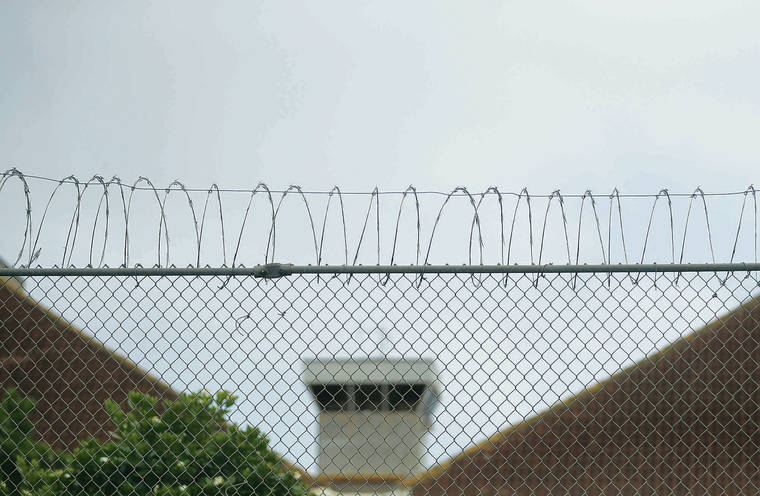Jail populations drop amid virus pandemic

JAMM AQUINO / JAQUINO@STARADVERTISER.COM
Razor wire lines the perimeter fence at Oahu Community Correctional Center.
The number of inmates being housed in the state’s four jails has dropped by 25% in just over a month’s time as various segments of the criminal justice system work to lower populations in the facilities amid fears of widespread coronavirus infection.
No one in the state’s correctional system has tested positive for COVID-19 — three inmates have been tested, all with negative results. But local inmate advocates and health professionals point at some mainland facilities where situations turned bad quickly and warn it may just be a matter of time before that happens at Hawaii facilities, which have had a history of overcrowding.
The thinning of jail populations is happening as state Public Defender James Tabe attempts to convince the Hawaii Supreme Court to fast-track the release of hundreds more nonviolent inmates.
The total jail population Thursday was 1,641 inmates, 548 fewer than on March 2, according to the Department of Public Safety, which oversees the state correctional system.
DPS officials attribute the drop to a concerted effort by judges, police, prosecutors, public defenders and their own Intake Services Division to limit the number of people who need to be in jail.
“It’s not that anybody who’s been incarcerated has been miraculously released in response to COVID,” Public Safety Director Nolan Espinda told the Senate Special Committee on COVID-19 on Thursday.
Don't miss out on what's happening!
Stay in touch with breaking news, as it happens, conveniently in your email inbox. It's FREE!
“What it is, is that less and less people are being brought in because of the activities of the police department, the prosecutors and the public defenders, and as the people get routinely released on bail or after finishing their sentences, they’re not being replaced with new arrestees,” Espinda said.
Fewer people are getting arrested, and fewer are being charged immediately by prosecutors.
“We’re trying not to put people in unless they’re a danger,” Honolulu Acting Prosecutor Dwight Nadamoto said, arguing that it might slow the drive to release more inmates through Tabe’s request to the Hawaii Supreme Court.
“If a person is a danger to the public, we will charge him right away and set bail,” Nadamoto said. “But if a person is not a danger, then now we won’t.”
For instance, transients without a home address would under normal circumstances be charged right away because of concerns they wouldn’t be located later. “I’m not saying we’re letting them go; we’re just not charging them right away,” he said.
Tabe, the public defender, said his staff has been successful in convincing judges to release pretrial felony defendants across all four counties. But he noted that success has come despite objections raised in many of the cases by Nadamoto’s deputy prosecutors.
“They are innocent until proven guilty; they just couldn’t afford the bail,” Tabe said. “The serious, violent offenders stay in jail, but we’re able to get a lot of (other) folks out.”
The largest and smallest of the four state-run jails are now operating below operational capacity. Oahu Community Correctional Center in Kalihi housed 906 inmates Thursday, down from 1,201 on March 2. OCCC’s operational capacity is 954. Kauai Community Correctional Center housed 101 inmates Thursday, down from 143 on March 2 and below its operational capacity of 128.
The Hawaii Community Correctional Center in Hilo housed 304 inmates Thursday, still significantly over its operational capacity of 226 but a decrease from 395 on March 2. The Maui Community Correctional Center’s population of 330 is also above its operational capacity of 301 but still a decrease from the 450 inmates in its population on March 2.
Those numbers aren’t good enough to ease the potential for widespread infection, Tabe said.
“Operational capacity still means two to possibly three persons to a cell, and they’re designed for one person per cell,” Tabe said, noting that OCCC’s design capacity is 628 inmates. “Our goal is to get to design capacity. The closer it gets to design (capacity), the easier it will be for DPS to manage any outbreak or any incident.”
Tabe’s petition calls for the court to commute or suspend the sentences of inmates serving time for petty misdemeanor or misdemeanor offenses. The petition also covers inmates who are serving jail time as a condition of probation for felony convictions.
The public defender’s office submitted a list of 426 inmates it believes fit the criteria for early release. All are in jails with the exception of about a handful who are in prisons.
Tabe insisted that no one considered dangerous is on the list.
Special Master Daniel Foley on Thursday submitted to the Hawaii Supreme Court his recommendation that individual judges determine which petitions filed for inmates seeking early release should be granted and under what conditions.
State officials have been taking other steps to decrease inmate populations at its prisons as well as jails. The Federal Bureau of Prisons this week agreed to accept the transfer of up to 100 additional state inmates at its Federal Detention Center near Daniel K. Inouye International Airport.
Meanwhile, DPS officials said, the department has been “working with judicial partners to implement more videoconferencing of arraignment and plea proceedings and bail motions,” thus reducing the amount of time pretrial detainees are held.




